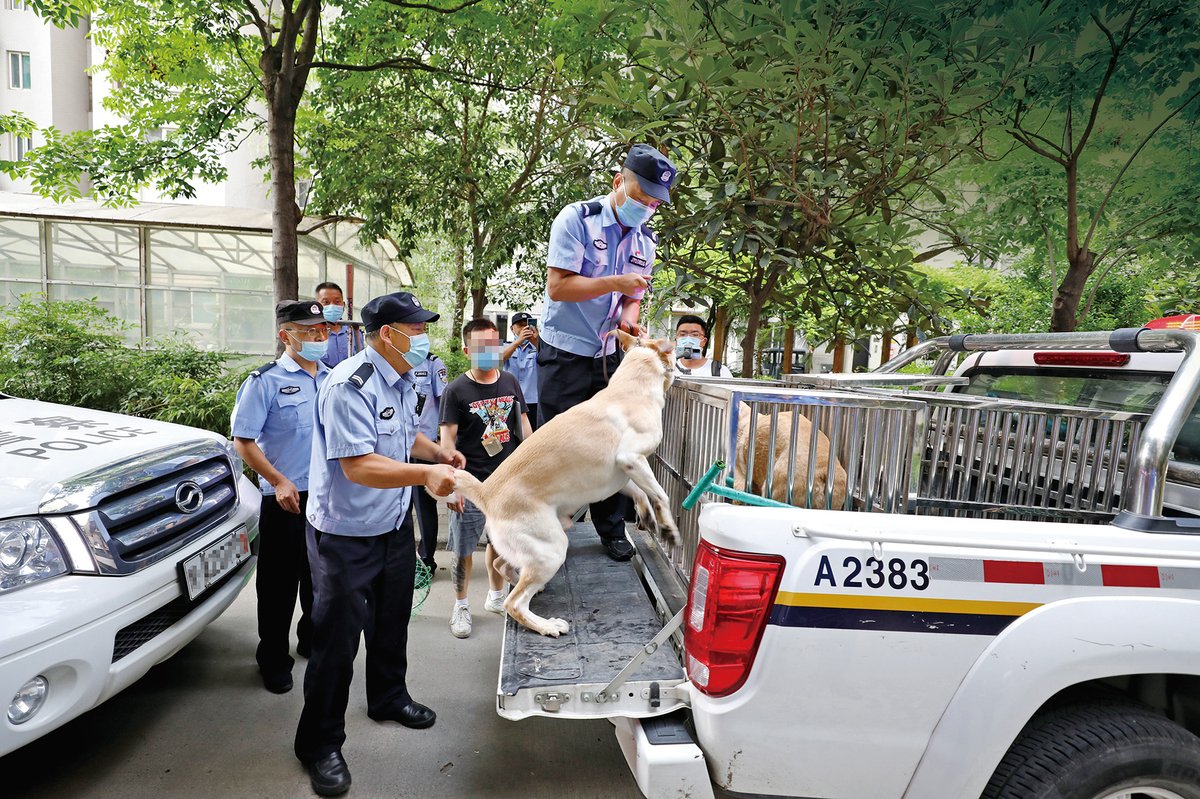Dog ownership in China is booming, but finding inclusive spaces for animals remains a tall order in most cities
Ever since Su Shan adopted Tangdou, a miniature poodle puppy weighing around 4 kilograms, just over a year ago, she feels she has “said goodbye to most forms of public transportation.”
That’s because in Qingdao, the picturesque seaside city in eastern China’s Shandong province where Su lives, dogs are banned from public transport (and taxis without the consent of the driver); as well as libraries, museums, memorial halls, sports venues, beaches, government offices, hospitals, and schools.
Even where there are no specific regulations, Su has been turned away from restaurants and farmers’ markets for bringing her dog, and has gotten used to calling up various venues to ask if Tangdou is allowed before she visits—and getting rejected. “Even when I put a leash and a diaper on her, a lot of people object,” Su tells TWOC. “They think the dog will attack, no matter its size.”
Dog ownership in China has boomed in the last two decades: There were 36.2 million people with dogs in 2021, according to a study by research firm Pethadoop, an increase of 260,000 from 2020. Businesses designed for doggy friends have flourished in tandem: Today, China’s pet food industry alone is worth a whopping 200 billion yuan.
But pet-friendly infrastructure in busy cities have failed to keep up. Chengdu, the capital of Sichuan province, has long limited each family to owning just one dog. Lawmakers in Zhengzhou, capital of Henan province, announced their intention to follow suit in 2021. In Beijing, dogs have never been formally given access to the city’s parks, only allowed into designated pet parks (although this was loosely enforced until 2018). Guangzhou, Guangdong province, has a string of regulations: from the places in the city where dogs can’t go, to what lengths of leash are required depending on the dog’s weight.
Many pet-owners and experts TWOC spoke to attribute this gap to the relatively short history of pet-ownership in China, compared to centuries of history where most of the population saw animals either as resources to be used on farms or pests to be eliminated. Before the Cultural Revolution, dogs “were more known as guard dogs and working dogs…instead of the companions we see today,” Mary Peng, CEO of the International Center for Veterinary Services, a private animal hospital in Beijing, tells TWOC. “They were meant to be big and aggressive, and that image stayed with the common psyche in China,” Peng says, explaining why some urban residents remain wary of dogs roaming their cities, and will even give pet dogs a wide berth if they encounter them in the streets.
Chinese laws and regulations on dogs and pets first emerged in the 1980s, when pet ownership began to increase. But an outbreak of rabies in 1981, attributed mainly to dog bites, led to the implementation of stricter measures to regulate stray dogs and push vaccinations to curb the disease. Up to 1993, dogs were simply banned from cities. These rules were updated that year, allowing urbanites to keep dogs if they registered them for 5,000 yuan.
As pet ownership increased, the price of registration fell to 1,000 yuan in 2003. Beijing’s rules on pet dogs have remained the same since that period: A dog should always be on a leash, even if it’s in a designated dog park. Only one dog can be registered for each household. Owners cannot walk their dogs during business hours (7 a.m. to 7 p.m.), and no dogs over 35 centimeters at shoulder height are allowed inside the Fifth Ring Road. Large dogs and breeds considered by some people as aggressive, such as Rottweilers and German Shepherds, are banned in Beijing and Shanghai.
In early 2019, Beijing started tightening up the rules due to growing complaints from its residents about dogs roaming freely and littering in parks, and enforcing previously lax registration requirements for pet dogs, in part due to rabies outbreaks in 2020. “If your dog is not registered, it’s automatically considered a stray. So, it has no protection if anyone decides to lodge a complaint and you will lose your dog to the authorities,” Peng tells TWOC.
Other cities have even stricter rules. Hangzhou, a large city in eastern China, introduced a daytime dog-walking ban in 2018. In November 2020, after receiving complaints of dogs biting children in Weixin county in Yunnan province, officials said they would ban dog walking in urban areas completely, and put in place a harsh three-strike penalty system: a warning for those caught walking their dogs the first time, a fine on the second strike, and the third time, the public security bureau would be sent to capture and kill the dog. The rule was later rescinded amid national and international furore.
For Su, these rules are not huge inconveniences. “I always put my dog on a leash, and I think [most people] are rule-abiding,” she says. However, she thinks her city is “not at the level yet” where everyone will abide by the rules on leashing dogs and picking up after them.
Fu Lin, a dog-owner in Linfen, a relatively small city of under 1 million people in northern China’s Shanxi province, agrees, but adds that she feels there are also people who use the rules to simply vent their prejudices about animals. “We always put our dogs on a leash, because we feel like that’s the right thing to do, but there are still people who will curse at us and say we’re breaking the law,” she complains, adding that she usually walks Eva, her 21-kilogram giant poodle, at midnight to avoid such conflicts.
“It is socially acceptable for people in Shanghai to dislike dogs,” says Nicoco Chan, an American photographer and videographer (and frequent TWOC collaborator) in Shanghai who owns two dogs, both under 7 kilograms. “This is a complete contrast to the US, where disliking dogs is a social sin that’s even been incorporated into pop culture,” she says, citing the sitcom Friends, where the character Chandler’s dislike of dogs is treated as a joke.
Chan has had many experiences of being asked to move out of people’s way on sidewalks when out with her dogs, and mentions a particularly memorable episode when a woman began screaming as soon as she saw Chan’s dog in a cafe, and had to be escorted out by staff.
“Though the older generation may have had a traumatic or frightful experience with a dog, for younger generations I suspect it is a learned behavior,” Chan believes. “It is very common for a parent to pull a child away from my dog while warning the child ‘careful, it will bite you.’”
For pet-owners, these cultural attitudes limit where they can go with their dogs. Chan says there are some dog-friendly cafes in Shanghai, but not many outdoor spaces where dogs are not banned—just a small enclosed section in the West Bund where dogs can be let off their leashes. A 37-year-old Beijing dog-owner, who preferred to be called Shan, tells TWOC that she and her three-legged rescue dog, Lucky, have been rejected by drivers on ride-hailing app DiDi on multiple occasions, with drivers worried about cleanliness and smells that might put off future passengers (thus influencing their ratings in the app), and wary the dog might become aggressive.
Some cities are taking measures to cater to their growing population of dog owners. As early as 2011, Panyu district of Guangzhou announced it would invest 280,000 yuan into building dog-walking spaces, and set up pilot areas in several parks and neighborhoods with dog toilets and exercise spaces cordoned off from the rest of the area. Parks in Zhuhai, Liwan, and other districts also set up designated dog areas, though TWOC couldn’t find any follow-up on several such projects in the pipeline. Across the bay in Hong Kong, authorities announced this year they will add 60 dog parks to the Special Administrative Region, bringing its total number to over 100.
DiDi also piloted “specialized pet taxis” in Beijing in March and April of this year, with drivers hailed through this service providing special accommodations to passengers with pets. Traveling longer distances remains a challenge, with many owners resorting to hiring a taxi or specialized pet transport company—as pets must ride in the cargo area on trains, planes, and the high-speed rail. “I’ve read lots of negative news about pets being hurt while being transported in cargo areas, so I’m very anxious about traveling [with my dog],” says Fu. “Because of this, I might choose not to go on a trip.”
In most cities, pet owners have to make do with what little slack authorities give them. Some owners of large dogs form group chats informing each other of the best times and areas to walk their dogs without running into law enforcement officers, and other dog-owners gather in designated open areas that the neighbors tacitly acknowledge to be unofficial dog parks—and that they and local authorities are mostly willing to tolerate, as long as the dogs don’t create any disturbance.
Shan mentions a “secret spot” she goes to next to Beijing’s Liangma River, a rare open park and river area in the city, to socialize with other dog owners, but says it has recently been shut down by the pandemic. Across China, pandemic measures have highlighted the lack of inclusion for pets in urban policies as well as societal attitudes: There were reports of pets being culled allegedly for disease-prevention, and Chan reports that Shanghai’s lockdown in the spring was “crazy stressful” for pet-owners like her, some of whom spent up to 2,000 yuan to move their dogs to a shelter if they got taken to quarantine. There were some cities like Shenzhen that set up pet quarantine hotels, but they remained the exception rather than the norm.
Chan says that people’s concerns about strays and irresponsible owners who do not vaccinate, train, or pick up after their dogs are “absolutely valid issues,” though she hopes more people can separate their criticism of owners from a rejection of dogs overall.
She feels that regulating pet shops to make sure they vaccinate their animals (as many sell puppies before they are old enough for their shots, for maximum cuteness), and pushing owners to vaccinate and register their dogs, could be a step toward removing the issues underlying some people’s fears. Similarly, Fu suggests creating more designated dog parks, and Su believes that outlining rules for how dogs ought to ride public transportation and long-distance trains—such as having a leash or muzzle—would be more humane than a one-size-fits-all ban.
“Overall, the issue is with a lack of experience and knowledge,” Chan says. “Kids are naturally fearless, so it’s too bad many of them end up being scared of dogs.”
– Additional research by Sam Davies, Alex Colville, Yang Tingting (杨婷婷), and Anita He (贺文文)
Off the Leash: Why are Pet-Friendly Spaces So Rare in China? is a story from our issue, “Public Affairs.” To read the entire issue, become a subscriber and receive the full magazine.















